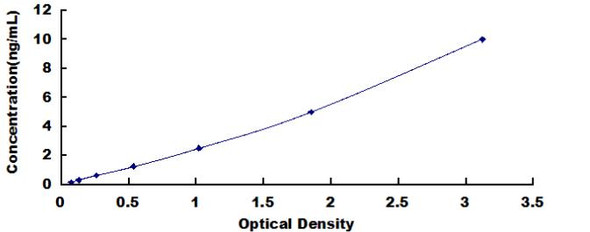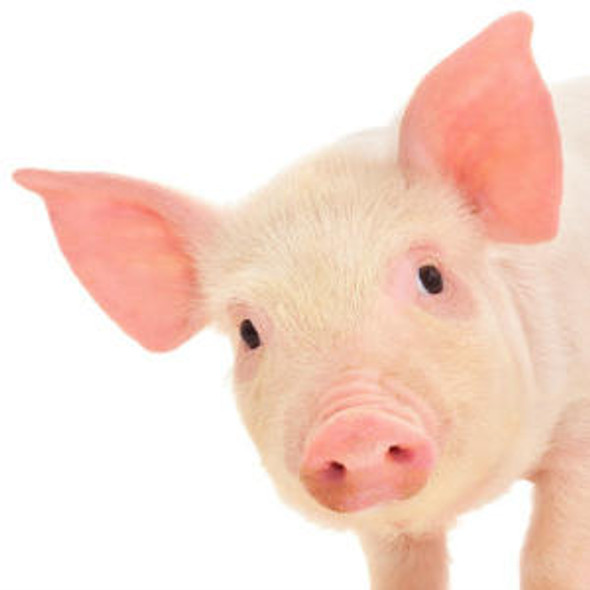Mouse Immunology ELISA Kits
Mouse CTLA4 (Cytotoxic T-Lymphocyte Associated Antigen 4) CLIA Kit (MOES00219)
- SKU:
- MOES00219
- Product Type:
- ELISA Kit
- ELISA Type:
- CLIA Kit
- Size:
- 96 Assays
- Sensitivity:
- 18.75pg/mL
- Range:
- 31.25-2000pg/mL
- ELISA Type:
- Sandwich
- Synonyms:
- CD152, CTLA-4, CELIAC3, GRD4, GSE, IDDM12
- Reactivity:
- Mouse
- Sample Type:
- Serum, plasma and other biological fluids
- Research Area:
- Immunology
Description
| Assay type: | Sandwich |
| Format: | 96T |
| Assay time: | 4.5h |
| Reactivity: | Mouse |
| Detection method: | Chemiluminescence |
| Detection range: | 31.25-2000 pg/mL |
| Sensitivity: | 18.75 pg/mL |
| Sample volume: | 100µL |
| Sample type: | Serum, plasma and other biological fluids |
| Repeatability: | CV < 15% |
| Specificity: | This kit recognizes Mouse CTLA4 in samples. No significant cross-reactivity or interference between Mouse CTLA4 and analogues was observed. |
This kit uses Sandwich-CLIA as the method. The micro CLIA plate provided in this kit has been pre-coated with an antibody specific to Mouse CTLA4. Standards or samples are added to the appropriate micro CLIA plate wells and combined with the specific antibody. Then a biotinylated detection antibody specific for Mouse CTLA4 and Avidin-Horseradish Peroxidase (HRP) conjugate are added to each micro plate well successively and incubated. Free components are washed away. The substrate solution is added to each well. Only those wells that contain Mouse CTLA4, biotinylated detection antibody and Avidin-HRP conjugate will appear fluorescence. The Relative light unit (RLU) value is measured spectrophotometrically by the Chemiluminescence immunoassay analyzer. The RLU value is positively associated with the concentration of Mouse CTLA4. The concentration of Mouse CTLA4 in the samples can be calculated by comparing the RLU of the samples to the standard curve.
| UniProt Protein Function: | CTLA-4: Inhibitory receptor acting as a major negative regulator of T-cell responses. The affinity of CTLA4 for its natural B7 family ligands, CD80 and CD86, is considerably stronger than the affinity of their cognate stimulatory coreceptor CD28. Genetic variation in CTLA4 influences susceptibility to systemic lupus erythematosus (SLE). SLE is a chronic, inflammatory and often febrile multisystemic disorder of connective tissue. It affects principally the skin, joints, kidneys and serosal membranes. SLE is thought to represent a failure of the regulatory mechanisms of the autoimmune system. Genetic variations in CTLA4 may influence susceptibility to Graves disease, an autoimmune disorder associated with overactivity of the thyroid gland and hyperthyroidism. Genetic variation in CTLA4 is the cause of susceptibility to diabetes mellitus insulin-dependent type 12 (IDDM12). A multifactorial disorder of glucose homeostasis that is characterized by susceptibility to ketoacidosis in the absence of insulin therapy. Clinical fetaures are polydipsia, polyphagia and polyuria which result from hyperglycemia-induced osmotic diuresis and secondary thirst. These derangements result in long-term complications that affect the eyes, kidneys, nerves, and blood vessels. Genetic variation in CTLA4 is the cause of susceptibility to celiac disease type 3 (CELIAC3). It is a multifactorial disorder of the small intestine that is influenced by both environmental and genetic factors. It is characterized by malabsorption resulting from inflammatory injury to the mucosa of the small intestine after the ingestion of wheat gluten or related rye and barley proteins. In its classic form, celiac disease is characterized in children by malabsorption and failure to thrive. 4 isoforms of the human protein are produced by alternative splicing. |
| UniProt Protein Details: | Protein type:Immunoglobulin superfamily; Membrane protein, integral Cellular Component: Golgi apparatus; membrane; perinuclear region of cytoplasm; plasma membrane; integral to membrane; clathrin-coated endocytic vesicle; external side of plasma membrane Biological Process: B cell receptor signaling pathway; negative regulation of T cell proliferation; positive regulation of apoptosis; immune system process; negative regulation of regulatory T cell differentiation; negative regulation of immune response; immune response; negative regulation of B cell proliferation; response to DNA damage stimulus |
| NCBI Summary: | This gene is a member of the immunoglobulin superfamily, and encodes a protein that functions as a negative regulator of T-cell responses. Alternatively spliced transcript variants encoding different isoforms have been described for this gene. [provided by RefSeq, Aug 2013] |
| UniProt Code: | P09793 |
| NCBI GenInfo Identifier: | 117606 |
| NCBI Gene ID: | 12477 |
| NCBI Accession: | P09793. 1 |
| UniProt Related Accession: | P09793 |
| Molecular Weight: | |
| NCBI Full Name: | Cytotoxic T-lymphocyte protein 4 |
| NCBI Synonym Full Names: | cytotoxic T-lymphocyte-associated protein 4 |
| NCBI Official Symbol: | Ctla4 |
| NCBI Official Synonym Symbols: | Cd152; Ly-56; Ctla-4 |
| NCBI Protein Information: | cytotoxic T-lymphocyte protein 4 |
| UniProt Protein Name: | Cytotoxic T-lymphocyte protein 4 |
| UniProt Synonym Protein Names: | Cytotoxic T-lymphocyte-associated antigen 4; CTLA-4; CD_antigen: CD152 |
| UniProt Gene Name: | Ctla4 |
| UniProt Entry Name: | CTLA4_MOUSE |
As the RLU values of the standard curve may vary according to the conditions of the actual assay performance (e. g. operator, pipetting technique, washing technique or temperature effects), the operator should establish a standard curve for each test. Typical standard curve and data is provided below for reference only.
| Concentration (pg/mL) | RLU | Average | Corrected |
| 2000 | 54690 56752 | 55721 | 55693 |
| 1000 | 23471 24477 | 23974 | 23946 |
| 500 | 11129 10935 | 11032 | 11004 |
| 250 | 5142 5446 | 5294 | 5266 |
| 125 | 2710 2506 | 2608 | 2580 |
| 62.5 | 1348 1274 | 1311 | 1283 |
| 31.25 | 667 681 | 674 | 646 |
| 0 | 27 29 | 28 | -- |
Precision
Intra-assay Precision (Precision within an assay): 3 samples with low, mid range and high level Mouse CTLA4 were tested 20 times on one plate, respectively.
Inter-assay Precision (Precision between assays): 3 samples with low, mid range and high level Mouse CTLA4 were tested on 3 different plates, 20 replicates in each plate.
| Intra-assay Precision | Inter-assay Precision | |||||
| Sample | 1 | 2 | 3 | 1 | 2 | 3 |
| n | 20 | 20 | 20 | 20 | 20 | 20 |
| Mean (pg/mL) | 110.19 | 275.02 | 739.19 | 121.20 | 301.85 | 670.49 |
| Standard deviation | 13.52 | 29.65 | 57.88 | 9.91 | 33.14 | 57.39 |
| C V (%) | 12.27 | 10.78 | 7.83 | 8.18 | 10.98 | 8.56 |
Recovery
The recovery of Mouse CTLA4 spiked at three different levels in samples throughout the range of the assay was evaluated in various matrices.
| Sample Type | Range (%) | Average Recovery (%) |
| Serum (n=5) | 91-103 | 98 |
| EDTA plasma (n=5) | 97-113 | 105 |
| Cell culture media (n=5) | 101-118 | 108 |
Linearity
Samples were spiked with high concentrations of Mouse CTLA4 and diluted with Reference Standard & Sample Diluent to produce samples with values within the range of the assay.
| Serum (n=5) | EDTA plasma (n=5) | Cell culture media (n=5) | ||
| 1:2 | Range (%) | 95-110 | 95-112 | 84-97 |
| Average (%) | 101 | 102 | 91 | |
| 1:4 | Range (%) | 96-111 | 92-108 | 102-117 |
| Average (%) | 104 | 99 | 108 | |
| 1:8 | Range (%) | 98-112 | 89-100 | 94-108 |
| Average (%) | 104 | 94 | 100 | |
| 1:16 | Range (%) | 98-115 | 95-106 | 98-113 |
| Average (%) | 106 | 100 | 104 |
An unopened kit can be stored at 4°C for 1 month. If the kit is not used within 1 month, store the items separately according to the following conditions once the kit is received.
| Item | Specifications | Storage |
| Micro CLIA Plate(Dismountable) | 8 wells ×12 strips | -20°C, 6 months |
| Reference Standard | 2 vials | |
| Concentrated Biotinylated Detection Ab (100×) | 1 vial, 120 µL | |
| Concentrated HRP Conjugate (100×) | 1 vial, 120 µL | -20°C(shading light), 6 months |
| Reference Standard & Sample Diluent | 1 vial, 20 mL | 4°C, 6 months |
| Biotinylated Detection Ab Diluent | 1 vial, 14 mL | |
| HRP Conjugate Diluent | 1 vial, 14 mL | |
| Concentrated Wash Buffer (25×) | 1 vial, 30 mL | |
| Substrate Reagent A | 1 vial, 5 mL | 4°C (shading light) |
| Substrate Reagent B | 1 vial, 5 mL | 4°C (shading light) |
| Plate Sealer | 5 pieces | |
| Product Description | 1 copy | |
| Certificate of Analysis | 1 copy |
- Set standard, test sample and control (zero) wells on the pre-coated plate and record theirpositions. It is recommended to measure each standard and sample in duplicate. Note: addall solutions to the bottom of the plate wells while avoiding contact with the well walls. Ensuresolutions do not foam when adding to the wells.
- Aliquot 100µl of standard solutions into the standard wells.
- Add 100µl of Sample / Standard dilution buffer into the control (zero) well.
- Add 100µl of properly diluted sample (serum, plasma, tissue homogenates and otherbiological fluids. ) into test sample wells.
- Cover the plate with the sealer provided in the kit and incubate for 90 min at 37°C.
- Aspirate the liquid from each well, do not wash. Immediately add 100µL of BiotinylatedDetection Ab working solution to each well. Cover the plate with a plate seal and gently mix. Incubate for 1 hour at 37°C.
- Aspirate or decant the solution from the plate and add 350µL of wash buffer to each welland incubate for 1-2 minutes at room temperature. Aspirate the solution from each well andclap the plate on absorbent filter paper to dry. Repeat this process 3 times. Note: a microplatewasher can be used in this step and other wash steps.
- Add 100µL of HRP Conjugate working solution to each well. Cover with a plate seal andincubate for 30 min at 37°C.
- Aspirate or decant the solution from each well. Repeat the wash process for five times asconducted in step 7.
- Add 100µL of Substrate mixture solution to each well. Cover with a new plate seal andincubate for no more than 5 min at 37°C. Protect the plate from light.
- Determine the RLU value of each well immediately.






